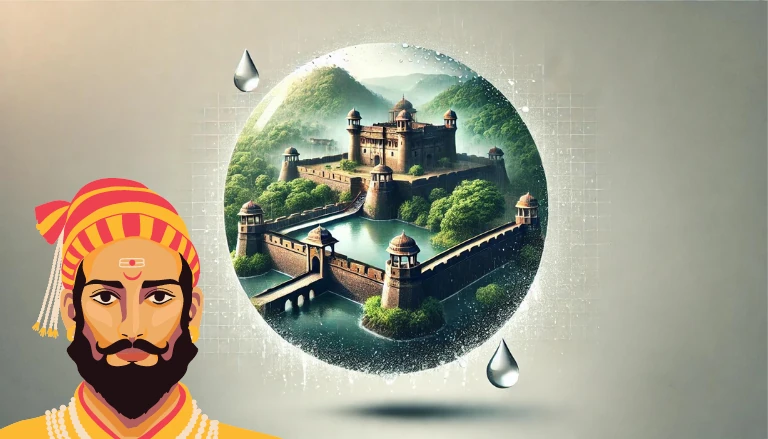During the reign of Chhatrapati Shivaji Maharaj, the great Maratha king, several forts were built on the rugged mountainous terrains of Maharashtra. One of the significant challenges for these forts was water storage and management. With limited access to natural water sources, the forts needed reliable methods to collect, store, and conserve water throughout the year, especially during long sieges. The water storage systems implemented on these forts were ingenious, utilizing traditional techniques that relied on rainwater harvesting and natural storage structures.
In this blog post, we’ll explore how water was stored on mountain forts during the time of Chhatrapati Shivaji Maharaj, the techniques used, and how these methods ensured a sustainable supply of water for the residents and soldiers stationed on these fortresses.
How Water Was Stored on Mountain Forts 🏞️💧
Mountain forts constructed during Chhatrapati Shivaji Maharaj’s era were equipped with innovative water storage systems designed to maximize the use of rainwater and natural springs. These systems were crucial for the survival of the fort’s inhabitants, as they provided water for drinking, cooking, and bathing. Here are some of the main techniques used for water storage on these forts:
1. Rock-Cut Cisterns and Tanks 🪨💧
One of the most common methods of storing water on mountain forts was through rock-cut cisterns and tanks. These large storage structures were carved directly into the rock, which made them durable and capable of holding large quantities of water.
- Example: Rajgad Fort features a rock-cut cistern known as Ganga Sagar Lake, which was used to store rainwater. Even today, the cisterns on this fort collect and store water, demonstrating the effectiveness of this ancient technique.
2. Natural Springs and Step Wells ⛲💧
Some forts had access to natural springs which provided a reliable source of fresh water. Additionally, step wells (or baolis) were often built to capture and store this water, making it accessible even during the dry season.
- Example: Sinhagad Fort has a natural spring called Dev Take, which has been a vital source of water for centuries.
3. Rainwater Harvesting 🌧️🌊
Rainwater harvesting was an essential technique used to ensure a continuous water supply. Forts were equipped with sluices and channels to direct rainwater into storage tanks or reservoirs. This method ensured that even during the monsoon season, all available rainwater was effectively captured and stored.
- Example: The fortifications of Raigad Fort include a series of channels that directed rainwater into storage tanks, maximizing water collection.
4. Reservoirs and Artificial Lakes 🌊🏞️
Some forts also had reservoirs or artificial lakes created by damming parts of the mountain. These large water bodies were designed to store rainwater and runoff, providing a long-term water supply for the fort.
- Example: At Lohagad Fort, a reservoir known as Pond of Ambar Khana was used for storing water. These large reservoirs were critical during sieges, ensuring the availability of water for an extended period.
Techniques for Water Conservation on Mountain Forts 💧🌄
The forts of Chhatrapati Shivaji Maharaj’s era were designed not just to store water but also to conserve it. Here are some of the methods used to ensure efficient water conservation:
1. Natural Filtration Systems 🧼💧
Many storage tanks were equipped with natural filtration systems that used layers of sand, charcoal, and gravel to filter impurities from the water. This ensured that the stored water remained clean and safe for drinking.
2. Slope Management and Runoff Control 🌊🛠️
The forts were built with slopes that directed rainwater runoff into storage tanks. Carefully designed sluices and drains managed the flow of water, minimizing wastage and preventing erosion.
3. Separate Tanks for Different Uses 🚰🏺
Some forts had multiple tanks with separate ones designated for drinking, bathing, and washing. This ensured that clean drinking water was always available, while other tanks could be used for non-potable purposes.
Importance of Water Storage on Chhatrapati Shivaji Maharaj’s Forts 🚰🏰
The efficient water management systems on these forts were vital for several reasons:
- Support During Sieges: Forts often faced long sieges, and a reliable water supply was essential for survival. Water storage ensured that soldiers and residents could endure these prolonged periods without needing external water sources.
- Self-Sufficiency: The forts were designed to be self-sufficient, with water storage systems that allowed them to withstand harsh weather conditions and isolation from the outside world.
- Adaptability: The water storage techniques were adapted to the unique geographical conditions of each fort, taking into account factors like altitude, climate, and natural water sources.
Real-Life Example: Raigad Fort Water Storage System 🏞️💧
Raigad Fort, the capital of the Maratha Empire under Chhatrapati Shivaji Maharaj, is a prime example of advanced water storage engineering. The fort has large reservoirs, rock-cut tanks, and channels that direct rainwater to storage areas. Even today, some of these tanks hold water, demonstrating the long-lasting impact of these traditional methods.
Lessons from Chhatrapati Shivaji Maharaj’s Era for Modern Water Conservation 🌍💧
The water storage systems on the mountain forts of Shivaji Maharaj’s era offer valuable lessons for modern water conservation:
- Rainwater Harvesting: Modern buildings and communities can adopt rainwater harvesting systems to collect and store water, just as it was done on these forts.
- Rock-Cut Reservoirs: Rock-cut reservoirs can be revived or adapted for current needs, particularly in regions prone to water shortages.
- Natural Filtration: Using natural filtration methods with sand and gravel can provide an eco-friendly way to purify water.
Ancient Water Storage Systems as Models for Sustainable Water Management 🏰💧
The water storage systems used on the mountain forts during Chhatrapati Shivaji Maharaj’s era demonstrate an impressive understanding of hydrology and sustainable water management. These techniques enabled the forts to maintain a reliable water supply, even in challenging conditions. Today, these age-old methods can inspire modern approaches to water conservation, showing us how traditional knowledge can be adapted for sustainable living.
By learning from the past, we can implement similar systems to conserve water, reduce dependency on external sources, and promote self-sufficiency in our communities.
Discover more from Green Ecosystem - Renewable Energy, Agriculture, and Environmental Sustainability
Subscribe to get the latest posts sent to your email.


